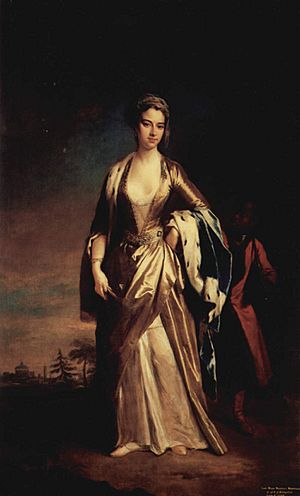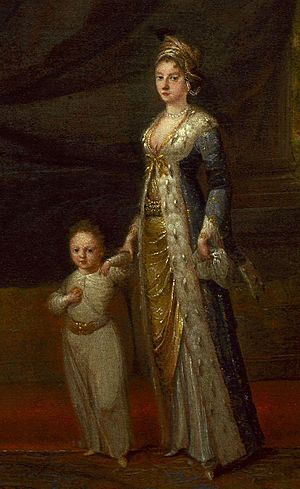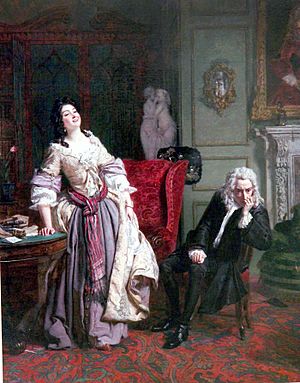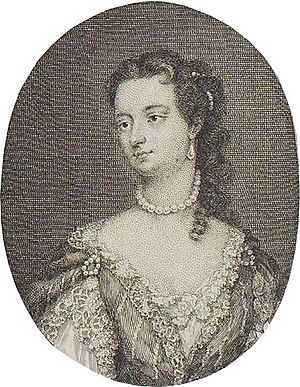Lady Mary Wortley Montagu facts for kids
Quick facts for kids
Lady
Mary Wortley Montagu
|
|
|---|---|

A painting of Mary Wortley Montagu by Jonathan Richardson the Younger
|
|
| Born |
Mary Pierrepont
15 May 1689 Holme Pierrepont Hall, Nottinghamshire, England
|
| Died | 21 August 1762 (aged 73) |
| Resting place | Grosvenor Chapel |
| Nationality | English |
| Occupation | Aristocrat, writer, and poet |
| Known for | Introducing and advocating for smallpox inoculation to Britain |
| Spouse(s) | |
| Children | |
| Parents |
|
Lady Mary Wortley Montagu (born Mary Pierrepont; 15 May 1689 – 21 August 1762) was an English noblewoman, writer, and poet. She is best known for her fascinating letters, especially her Turkish Embassy Letters. These letters describe her travels to the Ottoman Empire when her husband was the British ambassador there.
Lady Mary is also famous for bringing the idea of smallpox inoculation to Britain. This was a way to protect people from the deadly disease. She learned about it during her time in Turkey. Her writings often challenged the ideas of her time about women and their place in society.
Contents
Early life and learning
Lady Mary Pierrepont was born on 15 May 1689, in Nottinghamshire, England. She was the oldest child of Evelyn Pierrepont, who later became the first Duke of Kingston-upon-Hull.
Mary was a very smart and spirited child. She dreamed of doing great things. When she was seven, a group of important men called the Kit-Cat Club chose her as the "beauty of the season." They even engraved her name on a special glass!
Sadly, her mother died when Mary was young. Her grandmother then cared for Mary and her siblings for a short time before she also passed away. After that, Mary's father took care of them, but he didn't think girls needed much education.
How Lady Mary taught herself
Lady Mary's education was split between a governess and the family library at Thoresby Hall. She felt her governess gave her a "worst education" by teaching her "superstitious tales."
So, Lady Mary decided to teach herself. She would "steal" her education by hiding in the library for many hours each day. She taught herself Latin, a language that only men usually learned back then. By age thirteen, she was as good at Latin as most men!
She also loved to read. She read many plays and romances, both French and English. By the time she was 14 or 15, she had already written her own poems and stories. She even wrote to two bishops, Thomas Tenison and Gilbert Burnet, who helped her learn more. Her father was impressed with how much she learned on her own.
Marriage and journey to Turkey

By 1710, Lady Mary had two possible husbands: Edward Wortley Montagu and Clotworthy Skeffington. Lady Mary became friends with Edward through his sister, Anne. After Anne died, Lady Mary and Edward started writing letters to each other. They kept this a secret from her father.
Lady Mary's father wanted her to marry Clotworthy Skeffington. But Lady Mary didn't want to. To avoid this marriage, she secretly ran away and married Edward Wortley Montagu. Their marriage happened on 15 October 1712.
Life before the Ottoman Empire trip
Lady Mary and Edward spent their first years of marriage in England. Their son, also named Edward, was born in 1713.
In 1714, her husband became a Junior Commissioner of the Treasury. When Lady Mary joined him in London, she became very popular at court because of her quick wit and beauty. She was friends with important people like King George I and Alexander Pope.
In 1715, Lady Mary got smallpox. She survived, but the disease left her face scarred.
Journey to Constantinople

In 1716, Edward Wortley Montagu was made the British Ambassador to Constantinople (now Istanbul, Turkey). His job was to help end a war between Austria and Turkey. Lady Mary went with him on this journey.
They traveled through Vienna and Adrianople before reaching Constantinople. They stayed there until 1718. While in Turkey, their daughter, Mary, was born in 1718.
Lady Mary wrote many lively letters about her experiences in the Ottoman Empire. These letters are collected in her famous book, Letters from Turkey. She described the beauty and kindness of the Ottoman women she met. She wrote about their different fashions and even visited a Turkish bath. She was surprised that women could stay in the hot bath for hours without getting sick!
She also wrote about how Turkish women reacted to her corset. They thought she was "locked up in that machine" by her husband! Lady Mary used her unique access to women's spaces to correct many wrong ideas that male travelers had written about the Ottoman Empire. She showed that Turkish women had more freedom and different customs than Europeans thought.
Smallpox inoculation

In the 1700s, smallpox was a very dangerous disease. It killed many people and left others with scars. Lady Mary's brother died from smallpox, and she herself was scarred by it.
While in the Ottoman Empire, Lady Mary saw a practice called inoculation (or variolation). This was a way to prevent smallpox. Old women in Turkey would take a tiny bit of pus from a mild smallpox blister and scratch it into a person's skin. This would give the person a very mild case of smallpox, which then made them immune to the more severe form of the disease.
Lady Mary was very impressed by this. She wanted to protect her own children. So, in March 1718, she had her nearly five-year-old son, Edward, inoculated in Turkey. He was the first English person to have this procedure! She wrote that her son was "singing and playing" after the inoculation.
When she returned to London, Lady Mary strongly promoted inoculation. But many doctors and people were against it because it was a folk treatment from another country.
Spreading the word
In April 1721, a smallpox outbreak hit England. Lady Mary had her daughter inoculated, and she made sure the public knew about it. This was the first time this was done in Britain.
She even convinced Caroline of Ansbach, the Princess of Wales, to try the treatment. To prove it was safe, seven prisoners who were about to be executed were offered inoculation instead. They all survived and were set free!
Despite some arguments, the Princess of Wales was convinced. Her two daughters were successfully inoculated in 1722. Lady Mary also wrote an article, using a fake name, to explain and support inoculation. Other royal families in Europe soon followed her lead.
Inoculation wasn't always perfectly safe, and people could still get a mild form of smallpox. But it was a big step forward. Later, Edward Jenner developed a much safer method called vaccination using cowpox. This led to the worldwide effort by the WHO to get rid of smallpox completely, which happened by 1979. Lady Mary's brave actions helped start the journey towards ending this terrible disease.
Later life and writings

After returning to England, Lady Mary focused more on her children and her writing. She spent time reading, writing, and editing her travel letters, though she didn't publish them herself at the time.
Lady Mary had a complicated friendship with the famous poet Alexander Pope. He admired her greatly, but she didn't feel the same way. Later, Pope even wrote poems that criticized her.
Lady Mary faced challenges with her children. Her son, Edward, often ran away from school and had a difficult relationship with his parents. Her daughter fell in love with a man who wasn't rich, and Lady Mary worried about her future. Despite her parents' disapproval, her daughter married him.
In 1739, Lady Mary left England without her husband, possibly due to a skin disease. She never met him again. She traveled widely in Europe, living in places like Venice, Florence, and Avignon. She continued to write letters to her daughter, discussing philosophy, books, and the education of girls.
When her husband died in 1761, Lady Mary decided to return to England. The journey was long and difficult. She reached London in January 1762. She rented a house, and her daughter and grandchildren visited her often.
In June 1762, Lady Mary became very ill with cancer. She died on 21 August 1762, at her home in London.
Her important writings

Lady Mary Wortley Montagu is most famous for her Turkish Embassy Letters, but she also wrote many poems and essays. Some of her poems and essays were printed during her lifetime, sometimes without her permission.
Her poems were often shared among her friends. She wrote about life in London and criticized unfair social rules, like the double standards for men and women. She also wrote a political newspaper called the Nonsense of Common-Sense.
Her most important work, the Turkish Embassy Letters, was published after her death. These letters describe her travels through Europe and the Ottoman Empire. They give a unique look at life in Turkey from a woman's perspective. Lady Mary was able to visit places and meet women that male travelers could not. She wrote about the "warmth and civility" of Ottoman women and how they had their own social spaces.
She also wrote about slavery in the Ottoman Empire. She noted that slaves there were often treated better than servants in other parts of the world.
Lady Mary's letters were very popular and inspired many other European women to travel and write. She showed that women's writings could offer new and important views of the world.
Even though her work was very well-received, some people didn't appreciate it as much as works by male writers. Lady Mary often used fake names to avoid criticism. Her granddaughter, Lady Louisa Stuart, later wrote about Lady Mary's life and helped publish more of her works.
Lady Mary Wortley Montagu's writings are still important today. They show her intelligence, her courage, and her unique view of the world.
Images for kids
See also
 In Spanish: Mary Montagu para niños
In Spanish: Mary Montagu para niños




